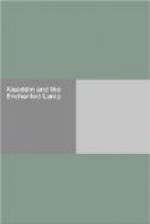IV.
Notwithstanding the discovery, as above set out, of three of the doubtful tales, Zeyn Alasnam, Aladdin and The Sleeper Awakened, in two MSS. (one at least undoubtedly authentic) of the Thousand Nights and One Night, I am more than ever of opinion that none of the eleven “interpolated” stories properly belongs to the original work, that is to say, to the collection as first put into definite form somewhere about the fourteenth century. [FN#19] “The Sleeper Awakened” was identified by the late Mr. Lane as a historical anecdote given by the historian El Ishaki, who wrote in the first quarter of the seventeenth century, and the frequent mention of coffee in both MSS. of Aladdin justifies us in attributing the composition of the story to (at earliest) the sixteenth century, whilst the modern vulgarisms in which they abound point to a still later date. Zeyn Alasnam (in the Sebbagh Ms. at least) is written in a much purer and more scholarly style than Aladdin, but its pre-existence in El Ferej bad esh Shiddeh (even if we treat as apocryphal Petis de la Croix’s account of the Hezar o Yek Roz) is sufficient, in the absence of contrary evidence, to justify us in refusing to consider it as belonging to the Thousand Nights and One Night proper. As shown by Galland’s own experience, complete copies of the genuine work were rarely to be met with, collections of “silly stories” (as the Oriental savant, who inclines to regard nothing in the way of literature save theology, grammar and poetry, would style them), being generally considered by the Arab bibliographer undeserving of record or preservation, and the fragmentary copies which existed were mostly in the hands of professional




